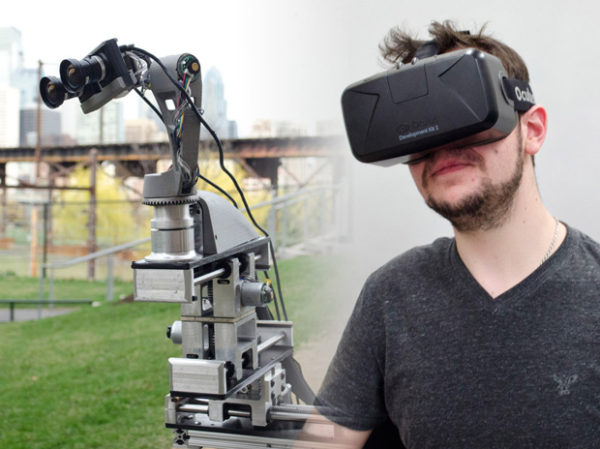Robotic VR system lets you view remote locations using Oculus Rift

Telepresence robots, or remote presence robots, enables viewing of distant locations on a viewing platform through a camera-equipped robotic surrogate. It has a wide range of practical applications such as in military and space research, but the primary prohibition it faces for wide adoption is the high cost. Generally, telepresence robots are very expensive, costing millions of dollars apiece. But a team of young engineers from the University of Pennsylvania are developing a new breed of telepresence robotics system that works with current virtual reality technologies to activate a broad range of uses without the high price.
The DORA, or the Dexterous Observational Roving Automaton, hopes to enable immersive interaction between the user and remote presence robots through the use of the Oculus Rift VR headset and a custom-built teleoperated robot that is attached with a camera. Developed by a team of four roboticists at the University of Pennsylvania, DORA works by linking a robot via a low-frequency radio band to the Oculus Rift. In turn, the motion sensors on the Oculus Rift detects motion from its user in real time with fairly low latency, and sends these motion data to the robotic system where it actuates in all six degrees of freedom – enabling the user to move and look around on whatever the robot’s camera is seeing without actually being there. At the heart of the system are Intel Edison and Arduino microcontrollers that processes all motion data for the system to work in parallel with the Oculus Rift.

Having said about the features of the DORA system, its creators are looking forward to open new possibilities in a wide variety of useful applications, such as video conferencing and virtual tourism, as well as for emergency response in critical situations where physical involvement of a person would be extremely risky. DORA is currently in the prototyping stage, and some of its hardware are limited by constraints. For example, its camera is equipped with a fairly average effective resolution of 976-by-582 pixels, having a frame rate of 30 frames per second. But it’s able to fit in a higher resolution camera that could capture HD footage. Aside from its budgetary limitations, there are also some challenges that DORA faces. One is that its latency is relatively higher at 70 milliseconds – compared to the acceptable limit of 60 milliseconds. Another is that the radio link is limited to a 7-kilometer line-of-sight range, and it must be equipped with a Wi-Fi or 4G connection in order to get a wider distance range. Fortunately the team is already working on improving these features.
The team behind DORA is composed of four engineering seniors hailing from the University of Pennsylvania. They are John C. Nappo, Emre Tanirgan, Peter A. Zachares, and Daleroy Sibanda, led by robotics professor Vijay Kumar. The team have done extensive testing of the system in a significant number of volunteers, and have received a majority of positive responses on the prototype.
For more information on the DORA Platform, please visit the following websites:
http://doraplatform.com
http://spectrum.ieee.org/automaton/robotics/robotics-hardware/upenn-dora-platform
http://www.engadget.com/2015/04/29/dora-oculus-rift-telepresence/

